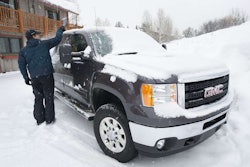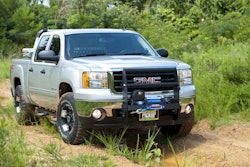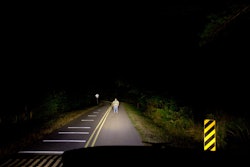 More Bars
More Bars
Adding a cell phone booster to your pickup for better cell coverage
Many remember the day of the portable “brick phone” when contractors wore it in a holster slung low like an old west gun fighter. The phone’s antenna could find that number ten rib every time you climbed into your pickup.
Calls were short and to the point because the meter was running. Still we were glad to be able to make the call from the field.
Now we take our cell phones and our cell coverage for granted. They have become as much a part of our lives as the pickups we drive and the machines we operate, which is why a weak signal can be so disruptive to our business and personal lives.
Boosting in-cab cell reception can be a real money maker, which is where Wilson electronics comes in with their line of cellular signal boosters.
 Wilson recommended mounting the interior antenna for the dual-band booster high on the inside of the driver's seat so other cell phone devices can take advantage of the enhanced signal.
Wilson recommended mounting the interior antenna for the dual-band booster high on the inside of the driver's seat so other cell phone devices can take advantage of the enhanced signal.
“The dual band mobile wireless is one of our better products for the construction industry,” says Jonathan Bacon, Director of Marketing, Wilson Electronics. “It not only improves cell phone signals, it also works with laptop data cards to provide higher data rates and faster speeds.
I tested a couple of Wilson’s wireless cell phone signal boosters in an area where contractor Brian Monroe recently did a job with no cell service.
As I approached the jobsite, the signal strength indicator on my cell phone went from one bar to “no service.”
Using the cell phone signal boosters I was able to see a dramatic improvement in cell service. In fact, the best combination moved the signal from “no service” to five bars 3G and phone calls made from the location were loud and clear.
 A toggle switch on the back of the power supply is a useful feature.
A toggle switch on the back of the power supply is a useful feature.
There are three main components to a mobile wireless unit. At the core of the system is a signal amplifier, which gets power from a 12V power point or cigarette lighter. The amplifier is connected to an external antenna located on the roof of the vehicle and an interior antenna mounted inside the vehicle.
The external antenna handles signals between the amplifier and the cell tower while the interior antenna transmits signals between amplifier and cell phone.
Wilson offers these systems with several variations on setup. Their popular Dual Band Mobile Wireless Cell Phone Signal Booster ($175) uses a rooftop antenna with a magnetic base, an under-seat amplifier and a rectangular interior antenna that attaches to the driver’s seat with a hook and loop strip.
 Wilson's Dual Band Mobile Wireless Cell Phone Signal Booster is anchored by their under-seat amplifier connected to a rooftop antenna with a magnetic base and a rectangular interior antenna that attaches to the driver's seat with a hook and loop strip.
Wilson's Dual Band Mobile Wireless Cell Phone Signal Booster is anchored by their under-seat amplifier connected to a rooftop antenna with a magnetic base and a rectangular interior antenna that attaches to the driver's seat with a hook and loop strip.
It works well for hand-held phone use and can accommodate a laptop data card or a second cell phone at the same time.
The more compact Wilson Sleek ($70) employs a phone cradle, which houses the amplifier and the interior antenna. It includes a smaller rooftop antenna with a magnetic base.
This unit works best with hands-free Bluetooth and has a bit less power than the dual-band signal amplifier. I saw an increase of three bars with the Sleek.
 Wilson's Sleek employs a phone cradle, which houses the amplifier and the interior antenna.
Wilson's Sleek employs a phone cradle, which houses the amplifier and the interior antenna.
In testing, I got the best results with the dual-band under-seat amplifier connected to the optional phone cradle, which replaces the seat mounted interior antenna. The direct contact with the phone helps this combination supply the best overall consistently strong signal boost in weak cell signal areas.
The contractor who wants to equip his pickups with boosters for frequent use will probably be best served by Wilson’s hardwired options.
They have applications available for exterior antennas that mount permanently on the roof with the antenna wire going through the roof.
 Wilson recommends routing the antenna wire throught the door seal for kits with magnetic antenna mounts. Some pickup owners may wish to use the rear center window.
Wilson recommends routing the antenna wire throught the door seal for kits with magnetic antenna mounts. Some pickup owners may wish to use the rear center window.
Interior wiring kits allow the installer to find a power source without using a power point. A power source that is off when the pickup is off will protect from draining the battery for extended vehicle non-use.
For those who will only use a booster very occasionally, you can keep the entire Sleek kit in a ziplock bag in your glove box and deploy it quickly when needed.
Contacts:
Wilson Electronics;
(800)204-4104







